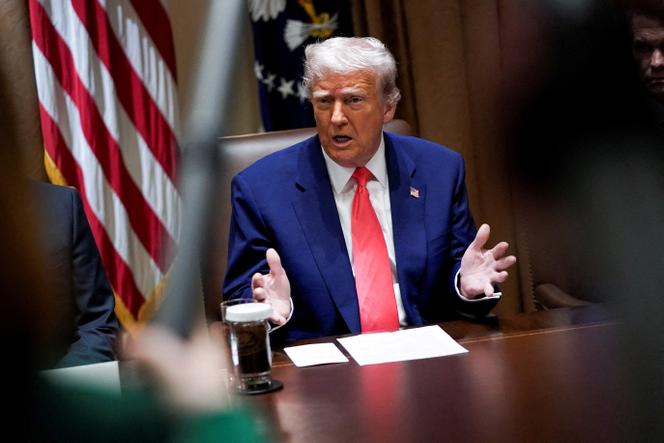


In the aftermath of this week's tariff whiplash, President Donald Trump is deciding exactly what he wants out of trade talks with as many as 75 nations in the coming weeks. Trump is also figuring out next steps with China. He upped his tariffs on Chinese goods to 145% after China placed retaliatory taxes of 84% on imports from the US. While his 90-day pause on other tariffs caused the stock market to rally on Wednesday, countries still face a baseline 10% import tax instead of the higher rates announced on April 2.
"There will be a transition cost and transition problems," Trump said at a cabinet meeting on Wednesday, April 10. "But in the end it’s going to be a beautiful thing."
Kevin Hassett, director of the White House National Economic Council, told Fox News’ Fox and Friends on Wednesday that the administration already has "offers on the table from more than 15 countries." Hassett said the next step will be determining exactly what Trump wants out of the negotiations. "We have a meeting today with all the top principals where we’re going to present to the president a list of what we think his priorities might look like. And I’m sure he’s going to, you know, have his own ideas about where to move things."
Going into Wednesday, the interest rate on a 10-year US Treasury note was increasing and approaching 4.5%. That meant the US government was having a tough time finding possible buyers for its debt. Trump on Wednesday said investors were getting "yippy," but after his tariff pause he described the bond market as "beautiful."
The S&P 500 stock index jumped 9.5% after the pause was announced. But reality crept back in on Thursday and the S&P 500 slumped nearly 3.5% as interest rates on 10-year US Treasury notes rose. Sure, Trump was no longer going to put a 20% tariff on goods from the European Union, a 24% tariff on Japan or 25% on South Korea. But those nations still have imports taxed at an elevated 10%, Trump's new baseline as trade talks begin. And tariffs went up against China, locking the world's two largest economies in a trade war.
Plus, the trade war has expanded with China, and 25% tariffs still apply to imported autos, steel and aluminum. Imports from Canada and Mexico, the two largest US trading partners, still face import taxes of as much as 25%. And Trump still plans tariffs on pharmaceutical drugs, lumber, copper and computer chips.
"While we appreciate the pause, the reciprocal tariff of 10% still represents more than double the tariff on imports of leather footwear from countries like Vietnam and Cambodia," said Tom Florsheim, CEO of the Weyco Group, a footwear company. "Even at this level, it means a significant cost increase that will impact consumers."
Because tariffs are taxes paid by importers, the costs generally get passed along to consumers and businesses in the form of higher prices and slower economic growth. The Budget Lab at Yale University estimated on Thursday that even with the pause, Trump's current tariff regime would pull down a household's average disposable income by $4,364.
Treasury Secretary Scott Bessent said that any trade agreements will be "bespoke" deals, rather than some overarching pact among a group of countries. Trump has laid out a series of grievances and goals regarding tariffs, but Canadian and European counterparts have said the actual asks from administration officials have been vague so far.
Trump has said he wants to eliminate the $1.2 trillion trade deficit, which means he no longer wants the US to import more goods than it exports to other nations. He also wants revenues from tariffs to offset his income tax cut plans. The president has also said he wants the tariffs to bring back factory jobs and raise workers’ wages.
European Commission President Ursula von der Leyen posted on X that she's "consistently advocated for a zero-for-zero tariff agreement between the European Union and the United States."
The Trump administration views China as violating basic trade norms with how it subsidizes its manufacturers, takes intellectual property from its global competitors, suppresses wages for its workers and manipulates its currency. The White House clarified that the 125% tariffs that Trump announced on Wednesday against China were actually 145%, once his previous 20% fentanyl tariffs were included.
Census Bureau data show the US ran a $295 billion trade deficit last year with China. Because US consumers and businesses are such a major customer of Chinese manufacturers, Bessent has said that gives the US an edge in terms of inflicting pain on that nation's economy through tariffs. Of course, China has also spent several years preparing for a trade war.
Trump at his cabinet meeting expressed hope that he could get an agreement with China, though he didn't offer any specifics on what he was seeking.
"Well, we’ll see what happens with China," Trump said. "I would love to be able to work a deal."
Meanwhile, Trump will need to deal with voters who might be frustrated over the higher price of electronics and other goods resulting from the trade wars.
"Many products that the US imports are predominantly from China: smartphones (73%), laptops (78%), video game consoles (87%), toys (77%), and also antibiotics for US livestock production," Zhang said in an email. "Resourcing from other countries will take time and result in much higher costs."
